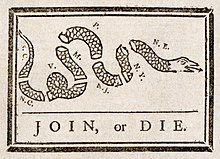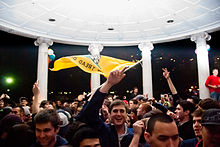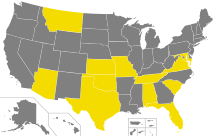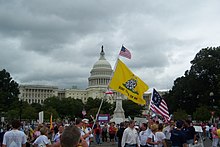Gadsden flag
 | |
| Use | Banner |
|---|---|
| Proportion | Not specified |
| Adopted | 1778 |
| Design | A yellow banner charged with a coiled rattlesnake facing towards the hoist, the words "DONT TREAD ON ME" positioned below the snake. |
| Designed by | Christopher Gadsden |
The Gadsden flag is a historical American flag with a yellow field depicting a rattlesnake coiled and ready to strike. Positioned below the rattlesnake are the words "DONT TREAD ON ME."[note 1] The flag is named after American general and politician Christopher Gadsden (1724–1805), who designed it in 1775 during the American Revolution. It was used by the Continental Marines as an early motto flag, along with the Moultrie flag.
History
Snake symbolism

The timber rattlesnake can be found in the area of the original Thirteen Colonies. Its use as a symbol of the American colonies can be traced back to the publications of Benjamin Franklin. In 1751, he made the first reference to the rattlesnake in a satirical commentary published in his Pennsylvania Gazette. It had been the policy of Great Britain to send convicted criminals to the Americas, so Franklin suggested that they thank the British by sending rattlesnakes to Britain.[2]
In 1754, during the French and Indian War, Franklin published his famous woodcut of a snake cut into eight sections. It represented the colonies, with New England joined together as the head and South Carolina as the tail, following their order along the coast. Under the snake was the message "Join, or Die". This was the first political cartoon published in an American newspaper.
As the American colonies came to identify more with their own communities and the concept of liberty, rather than as vassals of the British empire, icons that were unique to the Americas became increasingly popular. The rattlesnake, like the bald eagle and American Indian, came to symbolize American ideals and society.[3][4]
As the American Revolution grew, the snake began to see more use as a symbol of the colonies. In 1774, Paul Revere added Franklin's iconic cartoon to the nameplate of Isaiah Thomas' paper, the Massachusetts Spy, depicted there as fighting a British dragon.[5] In December 1775, Benjamin Franklin published an essay in the Pennsylvania Journal under the pseudonym American Guesser in which he suggested that the rattlesnake was a good symbol for the American spirit:
I recollected that her eye excelled in brightness, that of any other animal, and that she has no eye-lids—She may therefore be esteemed an emblem of vigilance.—She never begins an attack, nor, when once engaged, ever surrenders: She is therefore an emblem of magnanimity and true courage.—As if anxious to prevent all pretensions of quarreling with her, the weapons with which nature has furnished her, she conceals in the roof of her mouth, so that, to those who are unacquainted with her, she appears to be a most defenseless animal; and even when those weapons are shown and extended for her defense, they appear weak and contemptible; but their wounds however small, are decisive and fatal:—Conscious of this, she never wounds till she has generously given notice, even to her enemy, and cautioned him against the danger of stepping on her.—Was I wrong, Sir, in thinking this a strong picture of the temper and conduct of America?[6]
The rattlesnake symbol was first officially adopted by the Continental Congress in 1778 when it approved the design for the official Seal of the War Office (at that time and for many years thereafter, the War Office was a term associated with the Headquarters of the Army). At the top center of the Seal is a rattlesnake holding a banner which says: "This We'll Defend". According to the US Army's Institute of Heraldry, "'This We'll Defend,' on a scroll held by the rattlesnake is a symbol depicted on some American colonial flags and signifies the Army's constant readiness to defend and preserve the United States.' This design of the War Office Seal was carried forward—with some minor modifications—into the subsequent designs for the War Department's Seal, and the Department of the Army's Seal, Emblem and Flag. As such, the rattlesnake symbol has been in continuous official use by the US Army for over 236 years.
Gadsden's flag

In fall 1775, the Continental Navy was established by General George Washington in his role as Commander in Chief of all Continental Forces, before Esek Hopkins was named Commodore of the Navy. The Navy began with seven ships, often called "Washington Cruisers", that flew the "Liberty Tree Flag", depicting a green pine tree with the motto "Appeal to Heaven". This is according to the October 20, 1775 letter of Washington's aide Colonel Joseph Reed, which is stored in the Library of Congress.
Those first ships were used to intercept incoming British ships carrying war supplies to the British troops in the colonies both to deprive the British of the supplies and to supply to the Continental Army. One ship captured by Captain John Manley had 30,000 pairs of shoes on it. However, the admiralty agent demanded his 2+1⁄2 per cent commission before he would release the cargo for Washington's army, so many soldiers marched barefoot in the snow. To aid in this, the Second Continental Congress authorized the mustering of five companies of Marines to accompany the Navy on their first mission. The first Marines enlisted in the city of Philadelphia, and they carried drums painted yellow, depicting a coiled rattlesnake with thirteen rattles, and the motto "Don't Tread on Me." This is the first recorded mention of the future Gadsden flag's symbolism.[citation needed]
At the Congress, Continental Colonel Christopher Gadsden represented his home state of South Carolina. He was one of seven members of the Marine Committee who were outfitting the first naval mission.[7]: 289
Before the departure of that first mission in December 1775, the newly appointed commander-in-chief of the Navy, Commodore Esek Hopkins, received the yellow rattlesnake flag from Gadsden to serve as the distinctive personal standard of his flagship. It was displayed at the mainmast.[7]: 289 Hopkins had previously led The United Companies of the Train of Artillery of the Town of Providence, before being appointed to lead the Navy. The 1775 flag of the Providence Train of Artillery's featured a coiled timber rattlesnake and the motto "Do Not Tread on Me" along with an anchor, cannons and the motto "In God We Hope" on a gold background.[8] The flag presented to Hopkins as Commander of the Continental Navy is a simplified version of that design.
Gadsden also presented a copy of this flag to the Congress of South Carolina in Charleston, South Carolina. This was recorded in the South Carolina congressional journals on February 9, 1776:
Col. Gadsden presented to the Congress an elegant standard, such as is to be used by the commander in chief of the American Navy; being a yellow field, with a lively representation of a rattlesnake in the middle in the attitude of going to strike and these words underneath, "Don't tread on me."[9]
Variations in appearance
Many variations of the Gadsden flag exist:
- The motto sometimes includes an apostrophe in the word "Don't" and sometimes does not. Early written discussions uniformly include an apostrophe; however, as early as 1917, a flag reference book includes a picture of a version without the apostrophe.[7]: 339
- The typeface used for the motto is sometimes a serif typeface and other times sans-serif.
- The rattlesnake sometimes is shown as resting on a green ground, presumably grassy, and sometimes not. The green grass seems to be a recent addition; representations dating from 1885 and 1917 do not display anything below the rattlesnake.
- The rattlesnake usually faces to the left, and the early representations mentioned above face left. However, some versions of the flag show the snake facing to the right.
Other rattlesnake flags


The Culpeper Minutemen flag has a coiled rattlesnake and the same motto as the Gadsden flag. It has a white field, rather than yellow, and the additional motto "Liberty or Death" and the name "The Culpeper Minute Men". It is the flag of Virginia volunteers from the Culpeper area.
The John Proctor's Regiment flag of 1st Battalion Westmoreland County, Pennsylvania, had a coiled rattlesnake shown on its flag.[10]
The United Companies of the Train of Artillery of the Town of Providence already used a coiled rattlesnake on a field of gold with the motto "Do Not Tread On Me" on its flag. Before Esek Hopkins was named the first Commodore of the American Navy by the Continental Congress he served as a Brigadier General of the Rhode Island Militia Artillery,[11] and would have been familiar with the design of the flag.
All four of the American-designed "Rattlesnake Flags" show a coiled rattlesnake. The only other rattlesnake flag, the First Navy Jack, was "designed by" the English artist Thomas Hart as background art.[citation needed]
The traditional version of the First Navy Jack has an uncoiled rattlesnake and the same motto as the Gadsden flag, on a field of 13 horizontal red and white stripes. Flag experts (vexillologists) speculate that the English artist Thomas Hart either did not know about the practice of rattlesnakes to coil in defense, or did, and intended to insult the fledgling American Navy as a weak and vulnerable creature as a rattlesnake is when not coiled and ready to strike, slithering on the ground, trying to escape, with its motto "[Please] Don't Tread on Me!" However, others[who?] suggest the snake pictured on the flag was being provoked, and is striking. Hence the warning, "Don't tread on me [or I will strike]".[citation needed]
Modern use


Considered one of the first flags of the United States, the flag was later replaced by the current Stars and Stripes (or Old Glory) flag. Since the Revolution, the flag has seen resurgences as a symbol of American patriotism, disagreement with government, or support for civil liberties.
The First Navy Jack, which was not directly related to the Gadsden flag, has been in use by the United States Navy since its beginnings. Unlike the Liberty Tree Flag with the letter by Colonel Joseph Reed that describes it, there is no document that describes the Snake on Stripes flag, only an image by English artist Thomas Hart in the background of a portrait of Commodore Esek Hopkins. In that same painting is a round "tree flag". The triangular Liberty Tree flag is derived from the only surviving tree flag from the Revolution, found in an old trunk in 1993 on Long Island, the 5th Regt. Connecticut Militia. The Snake on Stripes flag was included in a book of flags by Admiral Preble, but later Preble determined the flag not valid, so he removed it from his text. However, the book publisher used the old color plates, so the image was continued in the new edition and subsequently picked up by other publications and Webster's Dictionary.[citation needed]
In preparation for the 1976 bicentennial year, staff officers in the Secretary of the Navy's office sought a powerful image for the Navy's Bicentennial. One Navy officer saw the Snake on Stripes Flag in Webster's Dictionary, so the staff officers ordered a large number to give away as Navy promotional items and then turned to the Naval Historical Center to "get the history". They were told that the flag had probably never flown during the Revolution, based on Admiral Preble's later discoveries, but a decision was made to use the Snake on Stripes Flag, or the "Fake Snake Flag", anyway. Beginning in 1975, commissioned Navy ships flew this Jack in place of the Naval Jack (officially known as the Union Jack, not to be confused with the United Kingdom's flag) at the bow. In 1977, the Secretary of the Navy directed that the ship in active status with the longest total period of active service shall display the First Navy Jack until decommissioned or transferred to inactive service, at which time the flag shall be passed to the next ship in line with appropriate honors. The display of this jack by the oldest ship in the fleet is intended as a form of recognition to promote pride of service, enhance morale, and contribute to the tradition of naval service. USS Enterprise (CVN 65) became the oldest active ship in the United States Navy upon the decommissioning of USS Kitty Hawk (CV 63) on May 12, 2009. Enterprise is only the third aircraft carrier ever to hold the honor of flying the First Navy Jack.[12]
Since the first Patriot Day on September 11, 2002, which commemorates the lives lost in the September 11 attacks, the rattlesnake from the flag is also shown on the US Army's Drill Sergeant Identification Badge. After the Snake on Stripes Flag became the Navy's symbol for the Global War on Terrorism, flag history professionals[vague] (vexillologists) have done extensive research papers that further question the claim that the flag ever flew during the American Revolution, yet it continues to fly at the bow of American warships today.[citation needed]
For historical reasons, the Gadsden flag is still popularly flown in Charleston, South Carolina, the city where Christopher Gadsden first presented the flag and where it was commonly used during the revolution, along with the blue and white crescent flag of pre-Civil War South Carolina.
License plates

The Gadsden flag has become a popular specialty license plate in several states.
As of 2018[update], the following states offer the option of obtaining a Gadsden flag specialty license plate: Alabama, Arizona, Maryland,[13] Missouri, Montana,[14] Oklahoma, South Carolina, Tennessee,[15] Texas, and Virginia.[16][17]
Tea Party movement symbol

Beginning in 2009 at Tea Party rallies, the Gadsden Flag has been adopted as a symbol of the American Tea Party movement.[18][19][20][21] It was also displayed by members of Congress at Tea Party movement rallies.[22] Some lawmakers have called it a "political symbol" because of this association.[20][23]
In March 2013, a resident of New Rochelle, New York, put up a Gadsden flag at the city's vacant armory building. The city ordered its removal, fearing that the flag would be seen as political. The next month, a veterans group, the United Veterans Memorial & Patriotic Association, filed suit against the city.[24]
In popular culture
Athletic apparel company Nike uses the image of a rattlesnake coiled around a soccer ball for an ongoing, patriotic "Don't Tread on Me" campaign in support of the United States men's national soccer team. The phrase has become a rallying cry for American soccer fans and the Gadsden flag can occasionally be seen at national team games. A representation of the rattlesnake is contained on the inside of their uniforms, over the heart, with the initials "D.T.O.M.", which were used in the 2010 World Cup.[25]
In Hideo Kojima's video game Metal Gear Solid 2: Sons of Liberty a variation of the flag can be seen on one of the connecting bridges of the "Big Shell" facility, in a reference to both the original meaning and usage of the flag.[26]
In the apocalyptic 2006 CBS TV drama Jericho, the flag makes several appearances, most notably in the series finale as Jericho's acting mayor takes down the flag of the "Allied States of America", which had been flying at the town hall following a federal coup. He replaces the red, white, and blue flag of the central government with a Gadsden Flag which the previous mayor had kept framed in his office. The scene depicts a once-collaborationist character as finally having summoned the courage to be in open defiance against a supreme government.[27]
The heavy metal band Metallica recorded a song called "Don't Tread on Me" on their self-titled fifth studio album, released in 1991. The album cover features a dark grey picture of a coiled rattlesnake like the one found on the Gadsden Flag. The song's lyrics refer to political phrases from the American Revolutionary War.
"Don't Tread On Me" is a song from hard rock supergroup Damn Yankees on their 1992 studio album Don't Tread.
In addition, in the hit series The West Wing, Sam Seaborn's office displays the flag hanging above his cabinet.
NASCAR driver Carl Edwards displayed the Gadsden Flag next to his facsimile signature on his race car.[28]
In WWE, the tag team Real Americans, composed by Jack Swagger, Cesaro and the manager Zeb Colter, used the Gadsden Flag and the preamble "We the People".
In the 1979 novel Alongside Night, an organization called the Revolutionary Agorist Cadre, seeking a Second American Revolution, welcomes visitors to one of its undergrounds: "The room's only decoration was a modified Gadsden flag draped on the wall adjoining the bar and medical areas (opposite the door), a golden field with 'LAISSEZ-FAIRE!' in an upper left corner, a coiled rattlesnake facing left with its tongue out, and in the lower right, 'DONT TREAD ON ME!'" The Gadsden flag without the addition of "LAISSEZ-FAIRE!" is carried over into the 2014 Alongside Night movie adaptation in which the Gadsden flag is used by the Revolutionary Agorist Cadre as well as the traditional anarchist black flag.[29]
A verse from the 1970 song Uncle John's Band by the Grateful Dead contains the words "Their wall are built of cannonballs, their motto is 'Don't tread on me'".
Notes
References
- ^ Robert Lowth, A Short Introduction to English Grammar: With Critical Notes. 1794. pp. 67, 79.
- ^ Leepson, Marc; DeMille, Nelson (May 30, 2006). Flag: An American Biography. Macmillan. p. 12. ISBN 978-0-312-32309-7. Retrieved August 18, 2016.
- ^ "Mohawk was Emerging as a Symbol of Liberty in the New Land". Boston-tea-party.org. Retrieved July 29, 2014.
- ^ "Bald Eagle | National Bird". statesymbolsusa.org. Retrieved June 12, 2017.
- ^ "A More Perfect Union: Symbolizing the National Union of States". Library of Congress. Retrieved August 18, 2016.
- ^ "Franklin, Benjamin as quoted under his pseudonym, "The American Guesser"". From the Franklin Institute. December 27, 1775. Archived from the original on August 15, 2000. Retrieved August 18, 2016.
{{cite web}}: Unknown parameter|deadurl=ignored (|url-status=suggested) (help) - ^ a b c Byron McCandless; Gilbert Hovey Grosvenor (1917). Our flag number: with 1197 flags in full colors and 300 additional illustrations in black and white. National Geographic Society. Retrieved August 18, 2016.
- ^ "Flag of the United Train of Artillery of Providence - The Monticello Classroom". classroom.monticello.org. Retrieved April 3, 2018.
- ^ Hicks, Frederick Cocks (1918). The flag of the United States. United States Government Printing Office. p. 23. Retrieved August 18, 2016.
- ^ "A Rattlesnake Flag of the American revolution" (PDF). Archived from the original (PDF) on October 20, 2013. Retrieved August 18, 2016.
{{cite web}}: Unknown parameter|deadurl=ignored (|url-status=suggested) (help) - ^ "RootsWeb.com Home Page". www.rootsweb.ancestry.com. Retrieved April 3, 2018.
- ^ "Don't Tread on Me Flag History". Retrieved August 18, 2016.
- ^ http://www.mva.maryland.gov/vehicles/_images/plates/organizational/Gadsden-Pew-Club.gif
- ^ "Montana Department of Justice - License Plate Designs and Fees - Service Organizations & Associations".
- ^ "Friends of Sycamore Shoals State Historic Park". www.friendsofsycamoreshoals.org. Retrieved December 29, 2016.
- ^ "Seven States Now Offer 'Don't Tread on Me' License Plates; Is Yours on the List? - Tea Party News". Tea Party. Retrieved August 18, 2016.
- ^ Schwarz, Hunter (August 25, 2014). "States where you can get a 'Don't Tread On Me' license plate". The Washington Post. ISSN 0190-8286. Retrieved August 18, 2016.
- ^ "Gadsden flag denied over State Capitol". Wtnh.com Hartford CT. May 26, 2010. Archived from the original on December 13, 2010. Retrieved August 18, 2016.
{{cite web}}: Unknown parameter|deadurl=ignored (|url-status=suggested) (help) - ^ "Gadsden Flag Now Officially "Offensive" In America". Aipnews.com. Archived from the original on July 17, 2011. Retrieved August 18, 2016.
{{cite web}}: Unknown parameter|deadurl=ignored (|url-status=suggested) (help) - ^ a b "Connecticut Marines Fight for 'Don't Tread on Me' Flag Display". Fox News Channel. April 7, 2010. Retrieved August 18, 2016.
- ^ Scocca, Tom (June 13, 2010). "Flag daze". Boston Globe. Archived from the original on March 4, 2016. Retrieved August 18, 2016.
{{cite news}}: Unknown parameter|deadurl=ignored (|url-status=suggested) (help) - ^ "Gadsden Flags Flying Off the Shelves in Support of the Tea Party movement Tax Protest". Market Wire. April 16, 2009. Archived from the original on August 14, 2009. Retrieved August 18, 2016.
{{cite news}}: Unknown parameter|deadurl=ignored (|url-status=suggested) (help) - ^ "Tea Party movement flag will not fly at Connecticut Capitol". Necn.com. April 8, 2010. Archived from the original on September 5, 2012. Retrieved August 18, 2016.
{{cite web}}: Unknown parameter|deadurl=ignored (|url-status=suggested) (help) - ^ "Flag's Believed Ties To Tea Party Lead To Removal From New Rochelle Building". CBS 2 New York. April 22, 2013. Retrieved August 18, 2016.
- ^ "USA Men's Soccer Kit". Archived from the original on October 8, 2011.
{{cite web}}: Unknown parameter|deadurl=ignored (|url-status=suggested) (help) - ^ "Screenshot of Sons of Liberty Flag".
- ^ "Jericho Video – Jericho – Season 2: Episode 7: Patriots And Tyrants w/ Commentary". CBS. Retrieved August 18, 2016.
- ^ "Carl Edwards". Joe Gibbs Racing. Retrieved November 17, 2016.
- ^ "Alongside Night — Chapter XIV « J. Neil Schulman". jneilschulman.agorist.com. Retrieved November 17, 2016.
External links
Template:Wikipedia books
![]() Media related to Gadsden flag at Wikimedia Commons
Media related to Gadsden flag at Wikimedia Commons
- "A Flag of Conviction", The Claremont Institute
